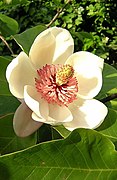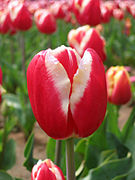Tepal

Atepalis one of the outer parts of aflower(collectively theperianth). The term is used when these parts cannot easily be classified as eithersepalsorpetals.This may be because the parts of the perianth are undifferentiated (i.e. of very similar appearance), as inMagnolia,or because, although it is possible to distinguish an outerwhorlof sepals from an inner whorl of petals, the sepals and petals have similar appearance to one another (as inLilium). The term was first proposed byAugustin Pyramus de Candollein 1827 and was constructed byanalogywith the terms "petal" and "sepal".[1][2](De Candolle used the termperigoniumorperigonefor the tepals collectively; today, this term is used as a synonym forperianth.)[3]
Origin
[edit]
Undifferentiated tepals are believed to be the ancestral condition inflowering plants.For example,Amborella,which is thought to have separated earliest in the evolution of flowering plants,[4]has flowers with undifferentiated tepals. Distinct petals and sepals would therefore have arisen by differentiation, probably in response to animalpollination.In typical modern flowers, the outer or enclosing whorl of organs forms sepals, specialised for protection of the flower bud as it develops, while the inner whorl forms petals, which attractpollinators.
Tepals formed by similar sepals and petals are common inmonocotyledons,particularly the "lilioid monocots".Intulips,for example, the first and second whorls both contain structures that look like petals. These are fused at the base to form one large, showy, six-parted structure (the perianth). Inliliesthe organs in the first whorl are separate from the second, but all look similar, thus all the showy parts are often called tepals. Where sepals and petals can in principle be distinguished, usage of the term "tepal" is not always consistent – some authors will refer to "sepals and petals" where others use "tepals" in the same context.
In some plants the flowers have no petals, and all the tepals are sepals modified to look like petals. These organs are described aspetaloid,for example, the sepals ofhellebores.When the undifferentiated tepals resemble petals, they are also referred to as "petaloid", as inpetaloid monocots,orders of monocots with brightly coloured tepals. Since they includeLiliales,an alternative name is lilioid monocots.
Properties and shape
[edit]Terms used in the description of tepals include pubescent (with dense fine, short, soft hairs, downy), puberulent (minutely pubescent, hairs barely visible to the naked eye) and puberulous (dense covering of very short soft hairs). Tepal shape is described in similar terms to those used for leaves (seeGlossary of leaf morphology).
Gallery
[edit]- Flowers with tepals
-
Flowers ofMagnolia×albashowing tepals in various stages of development
-
Tepals ofMagnolia×wieseneri
-
Ahelleboreflower showing the petaloid sepals
-
ASternbergia luteaflower showing the two whorls of tepals
-
A tulip flower showing the petal-like tepals
-
Tepals ofBlandfordia nobilis,anotherlilioid monocot
-
6 tepals (3 inner, 3 outer) of the rushJuncus squarrosus
See also
[edit]References
[edit]- ^Augustin Pyramus de Candolle (1827).Organographie végétale, ou Description raisonnée des organes des plantes; pour servir de suite et de développement a la théorie élémentaire de la botanique, et d'introduction a la physiologie végétale et a la physiologie végétale et a la description des familles.Paris: Deterville. p. 503.
- ^Augustin Pyramus de Candolle (1841).Vegetable organography; or, An analytical description of the organs of plants.Vol. 2. Translated by Boughton Kingdon. London: Houlston & Stoneman. p. 90.
- ^Stearn, William Thomas (2004).Botanical Latin(p/b ed.). David & Charles/Timber Press.ISBN978-0-7153-1643-6.p. 39.
- ^Ronse De Craene, L. P. (2007)."Are Petals Sterile Stamens or Bracts? The Origin and Evolution of Petals in the Core Eudicots".Annals of Botany.100(3): 621–630.doi:10.1093/aob/mcm076.PMC2533615.PMID17513305.
- Botany: A Brief Introduction To Plant Biology- 5th ed. Thomas L. Rost; T. Elliot Weier - Wiley & Sons 1979ISBN0-471-02114-8.
- Plant Systematics- Jones; Samuel - McGraw-Hill 1979ISBN0-07-032795-5.







